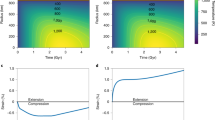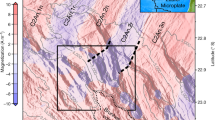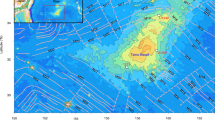Abstract
The deep nitrogen-covered basin on Pluto, informally named Sputnik Planitia, is located very close to the longitude of Pluto’s tidal axis1 and may be an impact feature2, by analogy with other large basins in the Solar System3,4. Reorientation5,6,7 of Sputnik Planitia arising from tidal and rotational torques can explain the basin’s present-day location, but requires the feature to be a positive gravity anomaly7, despite its negative topography. Here we argue that if Sputnik Planitia did indeed form as a result of an impact and if Pluto possesses a subsurface ocean, the required positive gravity anomaly would naturally result because of shell thinning and ocean uplift, followed by later modest nitrogen deposition. Without a subsurface ocean, a positive gravity anomaly requires an implausibly thick nitrogen layer (exceeding 40 kilometres). To prolong the lifetime of such a subsurface ocean to the present day8 and to maintain ocean uplift, a rigid, conductive water-ice shell is required. Because nitrogen deposition is latitude-dependent9, nitrogen loading and reorientation may have exhibited complex feedbacks7.
This is a preview of subscription content, access via your institution
Access options
Subscribe to this journal
Receive 51 print issues and online access
$199.00 per year
only $3.90 per issue
Buy this article
- Purchase on Springer Link
- Instant access to full article PDF
Prices may be subject to local taxes which are calculated during checkout



Similar content being viewed by others
References
Moore, J. M. et al. The geology of Pluto and Charon through the eyes of New Horizons. Science 351, 1284–1293 (2016)
Schenk, P.M. et al. A large impact origin for Sputnik Planum and surrounding terrains, Pluto? Div. Planet. Sci. Meet. 47, abstr. 200.06 (2015)
Searls, M. L. et al. Utopia and Hellas basins, Mars: twins separated at birth. J. Geophys. Res. 111, E08005 (2006)
Zuber, M. T. et al. Topography of the northern hemisphere of Mercury from MESSENGER laser altimetry. Science 336, 217–220 (2012)
Rubincam, D. P. Polar wander on Triton and Pluto due to volatile migration. Icarus 163, 469–478 (2003)
Nimmo, F. & Matsuyama, I. Reorientation of icy satellites by impact basins. Geophys. Res. Lett. 34, L19203 (2007)
Keane, J. T., Matsuyama, I., Kamata, S. & Steckloff, J. K. Reorientation and faulting of Pluto due to volatile loading within Sputnik Planitia. Nature http://dx.doi.org/10.1038/nature20120 (2016)
Robuchon, G. & Nimmo, F. Thermal evolution of Pluto and implications for surface tectonics and a subsurface ocean. Icarus 216, 426–439 (2011)
Binzel, R. P. et al. Climate zones on Pluto and Charon. Icarus http://dx.doi.org/10.1016/j.icarus.2016.07.023 (2016)
McKinnon, W. B. et al. Convection in a volatile nitrogen-ice-rich layer drives Pluto’s geological and atmospheric vigour. Nature 534, 82–85 (2016)
Trowbridge, A. J. et al. Vigorous convection as the explanation for Pluto’s polygonal terrain. Nature 534, 79–81 (2016)
White, O. L., Schenk, P. M. & Dombard, A. J. Impact basin relaxation on Rhea and Iapetus and relation to past heat flow. Icarus 223, 699–709 (2013)
Bray, V. J. & Schenk, P. M. Pristine impact crater morphology on Pluto—expectations for New Horizons. Icarus 246, 156–164 (2015)
Johnson, B. C., Bowling, T. J., Trowbridge, A. J. & Freed, A. M. Formation of the Sputnik Planum basin and the thickness of Pluto’s subsurface ocean. Geophys. Res. Lett. 43, 10068–10077 (2016)
Muller, P. M. & Sjogren, W. L. Mascons – lunar mass concentrations. Science 161, 680–684 (1968)
Melosh, H. J. et al. The origin of lunar mascon basins. Science 340, 1552–1555 (2013)
Wieczorek, M. A. & Phillips, R. J. Lunar multiring basins and the cratering process. Icarus 139, 246–259 (1999)
Kamata, S. & Nimmo, F. Impact basin relaxation as a probe for the thermal history of Pluto. J. Geophys. Res. 119, 2272–2289 (2014)
Nimmo, F. Non-Newtonian topographic relaxation on Europa. Icarus 168, 205–208 (2004)
McKinnon, W. B., Simonelli, D. P. & Schubert, G. in Pluto and Charon (eds Stern, S. A. & Tholen, D. J. ) 295–346 (Univ. Arizona Press, 1997)
Grundy, W. M. et al. Surface compositions across Pluto and Charon. Science 351, aad9189 (2016)
Hammond, N. P., Barr, A. C. & Parmentier, E. M. Recent tectonic activity on Pluto driven by phase changes in the ice shell. Geophys. Res. Lett. 43, 6775–6782 (2016)
Scott, T. A. Solid and liquid nitrogen. Phys. Rep. 27, 89–157 (1976)
Rubin, M. E., Desch, S. J. & Neveu, M. The effect of Rayleigh-Taylor instabilities on the thickness of undifferentiated crust on Kuiper Belt Objects. Icarus 236, 122–135 (2014)
Milbury, C. et al. Preimpact porosity controls the gravity signature of lunar craters. Geophys. Res. Lett. 42, 9711–9716 (2015)
Hamilton, D. P. et al. The rapid formation of Sputnik Planitia early in Pluto’s history. Nature http://dx.doi.org/10.1038/nature20586 (2016)
Matsuyama, I. & Nimmo, F. Rotational stability of tidally deformed planetary bodies. J. Geophys. Res. 112, E11003 (2007)
Manga, M. & Wang, C.-Y. Pressurized oceans and the eruption of liquid water on Europa and Enceladus. Geophys. Res. Lett. 34, L07202 (2007)
Brown, M. E. The compositions of Kuiper Belt Objects. Annu. Rev. Earth Planet. Sci. 40, 467–494 (2012)
Turcotte, D. L. et al. Role of membrane stresses in the support of planetary topography. J. Geophys. Res. 86, 3951–3959 (1981)
Nimmo, F. et al. Mean radius and shape of Pluto and Charon from New Horizons images. Icarus http://dx.doi.org/10.1016/j.icarus.2016.06.027 (2016)
Kargel, J. S. Ammonia water volcanism on icy satellites—phase relations at 1-atmosphere. Icarus 100, 556–574 (1992)
Comer, R. P., Solomon, S. C. & Head, J. W. Mars—thickness of the lithosphere from the tectonic response to volcanic loads. Rev. Geophys. 23, 61–92 (1985)
Willemann, R. J. Reorientation of planets with elastic lithospheres. Icarus 60, 701–709 (1984)
Moore, W. B. & Schubert, G. The tidal response of Europa. Icarus 147, 317–319 (2000)
Soderblom, J. M. et al. The fractured Moon: production and saturation of porosity in the lunar highlands from impact cratering. Geophys. Res. Lett. 42, 6939–6944 (2015)
Petrenko, V. F. & Whitworth, R. W. Physics of Ice (Clarendon Press, 1999)
Acknowledgements
New Horizons was built and operated by the Johns Hopkins Applied Physics Laboratory in Laurel, Maryland, USA, for NASA. We thank the many engineers, flight controllers and others who have contributed to the success of the New Horizons mission and NASA’s Deep Space Network for a decade of excellent support to New Horizons. We thank B. Johnson for discussions on impact physics and J. Conrad for cryovolcanism calculations.
Author information
Authors and Affiliations
Consortia
Contributions
D.P.H. originated the reorientation hypothesis. F.N. developed the subsurface ocean scenario and carried out the bulk of the calculations. C.J.B. calculated the effect of realistic basin geometries and ejecta blanket. P.M.S. and R.A.B. provided the stereo topography. All authors read or commented on the manuscript.
Corresponding author
Ethics declarations
Competing interests
The authors declare no competing financial interests.
Additional information
Reviewer Information
Nature thanks G. Collins and the other anonymous reviewer(s) for their contribution to the peer review of this work.
Extended data figures and tables
Extended Data Figure 1 Schematic of the way in which the gravity anomaly is affected by an uplifted ocean and the thickness of the nitrogen layer.
a–c, Either a nitrogen layer more than 40 km thick (b) or an uplifted ocean (c) could result in the present-day positive gravity anomaly at Sputnik Planitia; if neither is present, then a negative gravity anomaly results (a). The peak gravity anomaly is calculated using the flat-plate formula 2πGΔρh for each layer, where h represents the thickness, Δρ is the lateral density contrast and the densities of H2O ice, water and N2 ice are 0.92 g cm−3, 1.0 g cm−3 and 1.0 g cm−3 (ref. 23), respectively. In c, the gravitational contribution of the ocean is reduced as a result of upwards attenuation assuming a shell thickness of 150 km (see Methods). The structure in c is similar to the inferred structure of lunar mascon basins, which also show positive gravity anomalies (refs 15, 16).
Rights and permissions
About this article
Cite this article
Nimmo, F., Hamilton, D., McKinnon, W. et al. Reorientation of Sputnik Planitia implies a subsurface ocean on Pluto. Nature 540, 94–96 (2016). https://doi.org/10.1038/nature20148
Received:
Accepted:
Published:
Issue Date:
DOI: https://doi.org/10.1038/nature20148
This article is cited by
-
Sublimation-driven convection in Sputnik Planitia on Pluto
Nature (2021)
-
Antarctica as a reservoir of planetary analogue environments
Extremophiles (2021)
-
Science Goals and Mission Objectives for the Future Exploration of Ice Giants Systems: A Horizon 2061 Perspective
Space Science Reviews (2021)
-
Precometary organic matter: A hidden reservoir of water inside the snow line
Scientific Reports (2020)
-
Evidence for a hot start and early ocean formation on Pluto
Nature Geoscience (2020)
Comments
By submitting a comment you agree to abide by our Terms and Community Guidelines. If you find something abusive or that does not comply with our terms or guidelines please flag it as inappropriate.



